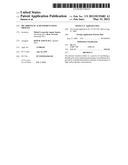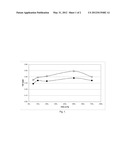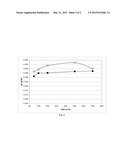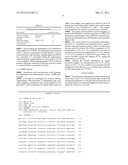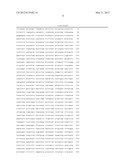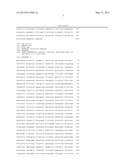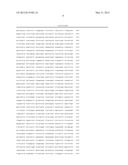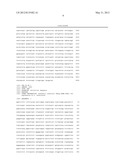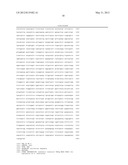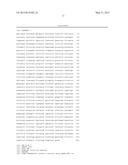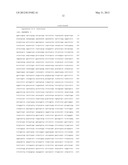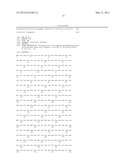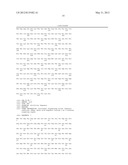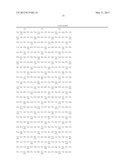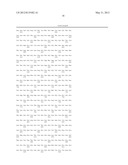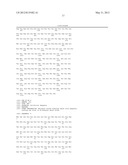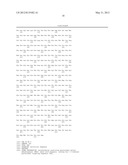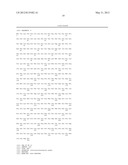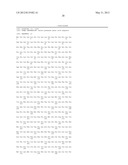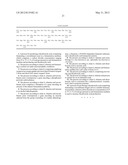Patent application title: DICARBOXYLIC ACID FERMENTATION PROCESS
Inventors:
Mickel Leonardus August Jansen (Den Haag, NL)
Rene Verwaal (Nootdorp, NL)
Assignees:
DSM IP ASSETS B.V.
IPC8 Class: AC12P744FI
USPC Class:
435142
Class name: Preparing oxygen-containing organic compound containing a carboxyl group polycarboxylic acid
Publication date: 2012-05-31
Patent application number: 20120135482
Abstract:
The present invention relates to a process for producing a dicarboxylic
acid, comprising fermenting a recombinant fungal cell in a suitable
fermentation medium, in the presence of high carbon dioxide
concentrations.Claims:
1. A process for producing a dicarboxylic acid, comprising fermenting a
recombinant yeast in a fermentation medium, which comprises a carbon
dioxide concentration ranging from 25 to 75 v/v % of total gas present in
said fermentation medium and producing said dicarboxylic acid.
2. The process according to claim 1, wherein said fermenting is carried out under microaerophilic conditions.
3. The process according to claim 2, comprising supplying oxygen at an oxygen uptake rate lower than 8.0 mmol oxygen/L/hour and above 0.01 mmol oxygen/L/hour.
4. The process according to claim 1, wherein said recombinant yeast overexpresses a gene encoding a phosphoenol pyruvate carboxykinase.
5. The process according to claim 1, wherein said recombinant yeast comprises a disruption of a gene encoding an enzyme of the ethanol fermentation pathway.
6. The process according to claim 5, wherein said enzyme is an alcohol dehydrogenase.
7. The process according to claim 1, wherein said recombinant yeast overexpresses a gene encoding an enzyme selected from the group consisting of a malate dehydrogenase, a fumarase, a NAD(H)-dependent fumarate reductase, and a dicarboxylic acid transporter protein.
8. The process according to claim 1, wherein said yeast, belongs to a Saccharomyces sp., optionally Saccharomyces cerevisiae.
9. The process according to claim 1, wherein said dicarboxylic acid is succinic acid.
10. The process according to claim 1, wherein said fermentation medium has a pH value of from 2 to 6.
11. The process according to claim 1, comprising recovering said dicarboxylic acid.
12. The process according to claim 1, wherein said process is carried out on an industrial scale.
13. The process according to claim 1, wherein said dicarboxylic acid is converted into a pharmaceutical, cosmetic, food, feed or polyester polymer.
14. A process for producing a dicarboxylic acid comprising fermenting a recombinant fungal cell in a suitable fermentation medium, wherein carbon dioxide in a concentration of 25 to 75 v/v % of total gas present in said fermentation medium is used to increase dicarboxylic acid production.
Description:
FIELD OF THE INVENTION
[0001] The present invention relates to a process for the production of dicarboxylic acids. In particular, it relates to the production of dicarboxylic acids by fermentation of yeast.
BACKGROUND OF THE INVENTION
[0002] Dicarboxylic acids, such as malic acid and succinic acid, are important compounds which are used in the food industry for the preparation and preservation of food, in the medical industry for the formulation of medical products and for other industrial uses, such as monomers for (bio) polymers. Dicarboxylic acids can be produced by petrochemical processes or fermentation based processes, by either bacteria or fungal cells. Bacteria that have been studied for improved succinic acid production are for example E. coli, Mannheimia sp., Actinobacillus sp. or Corynebacteria. A disadvantage of bacterial dicarboxylic acid fermentation processes is that such processes need to be carried out at high pH and neutralizing agents are needed to maintain the pH at a desired value. In addition, neutral pH processes require sterile process conditions, increasing the production costs further.
[0003] In contrast to bacteria, fungal cells are able to grow at low pH values and do not require strictly sterile process conditions, making fungal cells an attractive alternative for the production of dicarboxylic acids.
[0004] In WO2009/065780 recombinant fungal cells such as yeast and filamentous fungus were developed for the production of dicarboxylic acids, resulting in increased production levels of succinic acid and fumaric acid.
[0005] WO2008/14462 shows that the addition of carbon dioxide of up to 10 v/v % increased production levels of malic acid and succinic acid by a recombinant yeast cell, but higher concentrations of carbon dioxide did not further increase dicarboxylic acid production levels.
[0006] Despite the improvements made with genetically modified fungal cells for producing dicarboxylic acids, there is a need for further improving dicarboxylic acid production by fungal cells.
SUMMARY OF THE INVENTION
[0007] The present invention relates to a process for producing a dicarboxylic acid, comprising fermenting a recombinant fungal cell in a suitable fermentation medium, which comprises a carbon dioxide concentration ranging between 25 and 75 v/v % of total gas present in the fermentation medium and producing the dicarboxylic acid. Surprisingly, it was found that the yield of dicarboxylic acid (g/g sugar) in the process according to the present invention was increased significantly compared to a process comprising carbon dioxide outside of the concentration range of the invention.
[0008] Another advantage of the process according to the invention was that the specific productivity (g dicarboxylic acid/g sugar/h) was also increased significantly as compared to a process for the production of dicarboxylic acid comprising carbon dioxide outside of the concentration range of the invention.
Definitions
[0009] The terms "dicarboxylic acid" and "dicarboxylate", such as "succinic acid" and "succinate" have the same meaning herein and are used interchangeably, the first being the hydrogenated form of the latter.
[0010] The term fermenting or fermentation as used herein refers to the microbial production of compounds such as alcohols or acids from carbohydrates.
[0011] A recombinant fungal cell according to the present invention is defined herein as a cell which contains a disruption of a gene or contains, or is transformed or genetically modified with a nucleotide sequence that does not naturally occur in the fungal cell, or it contains additional copy or copies of an endogenous nucleic acid sequence. A wild-type fungal cell is herein defined as the parental cell of the recombinant cell.
[0012] Disruption, or deletion or knock-out of a gene means that part of a gene or the entire gene has been removed from a cell, or a gene has been modified such that the gene is not transcribed into the original encoding protein.
[0013] The term "homologous" when used to indicate the relation between a given (recombinant) nucleic acid (DNA or RNA), gene or polypeptide molecule and a given host organism or host cell, is understood to mean that in nature the nucleic acid or polypeptide molecule is produced by a host cell or organisms of the same species, preferably of the same variety or strain.
[0014] The term "heterologous" when used with respect to a nucleic acid (DNA or RNA) or protein refers to a nucleic acid, gene or protein that does not occur naturally as part of the organism, cell, genome or DNA or RNA sequence in which it is present, or that is found in a cell or location or locations in the genome or DNA or RNA sequence that differ from that in which it is found in nature. Heterologous nucleic acids or proteins are not endogenous to the cell into which it is introduced, but have been obtained from another cell or synthetically or recombinantly produced.
[0015] Sequence identity is herein defined as a relationship between two or more amino acid (polypeptide or protein) sequences or two or more nucleic acid (polynucleotide) sequences, as determined by comparing the sequences. Usually, sequence identities or similarities are compared over the whole length of the sequences compared. In the art, "identity" also means the degree of sequence relatedness between amino acid or nucleic acid sequences, as the case may be, as determined by the match between strings of such sequences.
[0016] Preferred methods to determine identity are designed to give the largest match between the sequences tested. Methods to determine identity and similarity are codified in publicly available computer programs. Preferred computer program methods to determine identity and similarity between two sequences include BLASTP and BLASTN, publicly available from NCBI and other sources (BLAST Manual, Altschul, S., et al., NCBI NLM NIH Bethesda, Md. 20894). Preferred parameters for amino acid sequences comparison using BLASTP are gap open 11.0, gap extension 1, Blosum 62 matrix.
[0017] There are known methods in the art for overexpression of genes encoding enzymes. A gene encoding an enzyme may be overexpressed by increasing the copy number of the gene coding for the enzyme in the cell, e.g. by integrating additional copies of the gene in the cell's genome, by expressing the gene from a centromeric vector, from an episomal multicopy expression vector or by introducing an (episomal) expression vector that comprises multiple copies of one or more gene(s). Preferably, overexpression of a gene encoding an enzyme according to the invention is achieved with a (strong) constitutive promoter.
[0018] Suitable promoters in fungal cells are known to the skilled man in the art. Suitable promotors may be, but are not limited to, TDH1, TDH3, GAL7, GAL10, GAL1, CYC1, HIS3, ADH1, PH05, ADC1, ACT1, TRP1, URA3, LEU2, ENO1, TPI1, AOX1, PGL, GPDA and GAPDH. Other suitable promoters include PDC1, GPD1, PGK1, and TEF1.
[0019] A gene encoding an enzyme may be ligated into a nucleic acid construct, for instance a plasmid, such as a low copy plasmid or a high copy plasmid. The fungal cell according to the present invention may comprise a single copy, but preferably comprises multiple copies of a gene, for instance by multiple copies of a nucleotide construct.
[0020] A nucleic acid construct may be maintained episomally and thus comprises a sequence for autonomous replication, such as an autonomously replicating sequence and a centromere (Sikorski and Hieter, 1989, Genetics 122, 19-27). A suitable episomal nucleic acid construct may e.g. be based on the yeast 2μ or pKD1 plasmids (Gleer et al., 1991, Biotechnology 9: 968-975), or the AMA plasmids (Fierro et al., 1995, Curr. Genet. 29:482-489). Alternatively, each nucleic acid construct may be integrated in one or more copies into the genome of the fungal cell. Integration into the cell's genome may occur at random by non-homologous recombination but preferably, the nucleic acid construct may be integrated into the cell's genome by homologous recombination as is well known in the art.
DETAILED DESCRIPTION OF THE INVENTION
[0021] In one embodiment the process for producing a dicarboxylic acid, comprising fermenting a recombinant fungal cell in a suitable fermentation medium comprises a carbon dioxide concentration ranging between 25 and 75 v/v %, for example between 35 and 65 v/v %, or between 40 and 60 v/v % of total gas present in the fermentation medium.
[0022] The carbon dioxide present in the fermentation medium may be added to the medium in the form of gaseous carbon dioxide in a gas flow, for instance a gas flow comprising carbon dioxide at a concentration between 25 and 75 v/v %. Suitable concentrations of carbon dioxide in a gas flow may range as described herein above.
[0023] The carbon dioxide may also be present in the fermentation medium by the addition of carbonate or bicarbonate salt, for instance calcium carbonate or calcium bicarbonate. Usually carbon dioxide is also formed during fermentation of a recombinant fungal cell in the process of the invention.
[0024] As used herein the term total gas in the fermentation medium comprises dissolved and not dissolved gas. Total gas in the fermentation medium comprises carbon dioxide and oxygen, and usually further comprises nitrogen and may comprise any gas molecules produced by fermenting the fungal cell, or added to the fermentation medium by e.g. sparging a gas flow through the fermentation medium.
[0025] It was found advantageous that total gas in the fermentation comprises oxygen, providing the recombinant fungal cell to generate energy via oxidation. Preferably, the total gas comprises low amounts of oxygen.
[0026] Preferably, the process as disclosed herein is carried out under aerobic conditions, preferably under microaerophilic conditions or oxygen limited conditions. Microaerophilic or oxygen limited conditions are reflected in the oxygen uptake rate (OUR). For example, the process described herein comprises supplying oxygen at an oxygen uptake rate lower than 8.0 mmol oxygen/L/hour and above 0.01 mmol oxygen/L/hour.
[0027] In one embodiment the OUR is lower than about 6.0 mmol oxygen/L/hour, preferably lower than about 5.0, 4.0, 3.0, or 2.0 mmol oxygen/L/hour, more preferably lower than about 1.0, or 0.5 mmol oxygen/L/hour, preferably above 0.01 mmol oxygen/L/hour. It was found that oxygen-limited conditions resulted in an increased yield of dicarboxylic acid in the process according to the present invention.
[0028] In one embodiment the fermentation medium in the process disclosed herein comprises a carbon source, preferably a carbon source selected from the group consisting of glucose, fructose, galactose, xylose, arabinose, sucrose, lactose, maltose, raffinose and glycerol. The fermentation medium usually comprises a nitrogen source such as ammonium or ureum. The fermentation medium may comprise biotin.
[0029] In one embodiment in the process for producing a dicarboxylic acid of the present disclosure, a recombinant fungal cell overexpresses a gene encoding a phosphoenol pyruvate (PEP) carboxykinase. Any PEP-carboxykinase catalyzing the reaction from phospoenol pyruvate to oxaloacetate (4.1.1.49) may be suitable for overexpression in a fungal cell. A fungal cell may overexpress a heterologous PEP carboxykinase, such as a PEP carboxykinase derived from Escherichia coli, Mannheimia sp., Actinobacillus sp., or Anaerobiospirillum sp., more preferably Mannheimia succiniciproducens, Actinobacillus succinogenes, or Anaerobiospirillum succiniciproducens. In one embodiment a gene overexpressing a PEP carboxykinase in a fungal cell in the process herein disclosed is expressed in the cytosol. In one embodiment a fungal cell of the present disclosure overexpresses a gene encoding a PEP-carboxykinase comprising an amino acid sequence that has at least 70, 80, 90, 95, 97, 98, 99 or 100% sequence identity with the amino acid sequence of SEQ ID NO: 6.
[0030] It was found advantageous that a recombinant fungal cell overexpresses a PEP-carboxykinase in the process for producing of a dicarboxylic acid in the presence of 25 to 75 v/v % carbon dioxide, since overexpression of PEP carboxykinase resulted in an increased fixation of carbon dioxide, i.e. the conversion of phosphoenol pyruvate (C3) to oxaloacetate (C4), resulting in a higher yield of dicarboxylic acid.
[0031] In another embodiment in the process for producing a dicarboxylic acid of the present disclosure a recombinant fungal cell overexpresses a pyruvate carboxylase (PYC), that catalyses the reaction from pyruvate to oxaloacetate (EC 6.4.1.1). Preferably the pyruvate carboxylase is active in the cytosol upon expression of the gene. Preferably, an endogenous or homologous pyruvate carboxylase is overexpressed.
[0032] In another embodiment, a recombinant fungal cell in the process for producing a dicarboxylic acid disclosed herein comprises a disruption of a gene encoding an enzyme of the ethanol fermentation pathway. A gene encoding an enzyme of an ethanol fermentation pathway, may be pyruvate decarboxylase (EC 4.1.1.1), catalyzing the reaction from pyruvate to acetaldehyde, or alcohol dehydrogenase (EC 1.1.1.1), catalyzing the reaction from acetaldehyde to ethanol. Preferably, a fungal cell in the process as disclosed herein comprises a disruption of one, two or more genes encoding an alcohol dehydrogenase. In the event the fungal cell is a yeast, e.g. Saccharomyces cerevisiae, the Saccharomyces cerevisiae preferably comprises a disruption of an alcohol dehydrogenase gene adh1 and/or adh2.
[0033] The process for producing a dicarboxylic acid of the present disclosure was found particularly advantageous for cells comprising a disruption of a gene encoding an enzyme of the ethanol fermentation pathway. This resulted in an increase of dicarboxylic acid yield and at the same time cells lacking the ability to produce energy in the form of ATP by ethanol fermentation, were able to fulfill the requirement of ATP formation via oxidation.
[0034] In another embodiment, a fungal cell disclosed herein comprises a disruption of a gene encoding a glycerol-3-phosphate dehydrogenase. Disruption of a gene encoding a glycerol-3-phosphate dehydrogenase usually results in a reduced formation of glycerol. In the event the fungal cell is a yeast, such as Saccharomyces cerevisiae, the fungal cell preferably comprises a disruption of a gpd1 gene.
[0035] In one embodiment the recombinant fungal cell further overexpresses a gene encoding an enzyme selected from the group consisting of a malate dehydrogenase, a fumarase, a (NAD(H)-dependent fumarate reductase, and a dicarboxylic acid transporter protein.
[0036] Preferred embodiments of these enzymes are as described herein below.
[0037] In one embodiment a fungal cell of the present disclosure further overexpresses a gene encoding a malate dehydrogenase (MDH) active in the cytosol upon expression of the gene. A cytosolic MDH may be any suitable homologous or heterologous malate dehydrogenase, catalyzing the reaction from oxaloacetate to malate (EC 1.1.1.37). Preferably a fungal cell comprises a gene encoding a malate dehydrogenase that has at least 70, 80, 90, 92, 94, 95, 96, 97, 98, 99 or 100% sequence identity with the amino acid sequence of SEQ ID NO: 9.
[0038] In another embodiment a fungal cell of the present disclosure further overexpresses a gene encoding a fumarase, that catalyses the reaction from malic acid to fumaric acid (EC 4.2.1.2). A gene encoding fumarase may be derived from any suitable origin, preferably from microbial origin, for instance a yeast such as Saccharomyces or a filamentous fungus, such Rhizopus oryzae. A fungal cell of the present disclosure may overexpress a nucleotide sequence encoding a fumarase that has at least 70%, or, 80, 90, 92, 94, 95, 96, 97, 98, 99, 100% sequence identity with the amino acid sequence of SEQ ID NO: 8. In one embodiment the enzyme catalysing the conversion of malic acid to fumaric acid is active in the cytosol upon expression of the nucleotide sequence. It was found that cytosolic activity of fumarase resulted in a high productivity of a dicarboxylic acid by the fungal cell.
[0039] In another embodiment the fungal cell overexpresses any suitable heterologous or homologous gene encoding a NAD(H)-dependent fumarate reductase, catalyzing the reaction from fumarate to succinate (EC 1.3.1.6). The NADH-dependent fumarate reductase may be a heterologous enzyme, which may be derived from any suitable origin, for instance bacteria, fungi, protozoa or plants. A fungal cell of the present discolsure comprises a heterologous NAD(H)-dependent fumarate reductase, preferably derived from a Trypanosoma sp, for instance a Trypanosoma brucei. In one embodiment the NAD(H)-dependent fumarate reductase is expressed in the cytosol. The fungal cell may overexpress a gene encoding a NAD(H)-dependent fumarate reductase that has at least 70, 80, 90, 92, 94, 96, 98, or 100% sequence identity with SEQ ID NO:7.
[0040] In another embodiment the fungal cell overexpresses a gene encoding a dicarboxylic acid transporter protein, for instance a malic acid transporter protein (MAE). A dicarboxylic acid transporter protein may be a homologous or heterologous protein. A dicarboxylic acid transporter protein may be derived from any suitable organism, for instance from Schizosaccharomyces pombe. A fungal cell as disclosed herein may comprise a dicarboxylic acid transporter protein which has at least 70, 80, 85, 90, 95, 99 or 100% sequence identity with SEQ ID NO: 10.
[0041] In one embodiment the fungal cell is a yeast or a filamentous fungus, for instance belonging to the genera Saccharomyces, Aspergillus, Penicillium, Pichia, Kluyveromyces, Yarrowia, Candida, Hansenula, Humicola, Issatchenkia, Torulaspora, Trichosporon, Brettanomyces, Rhizopus, Zygosaccharomyces, Pachysolen or Yamadazyma. The fungal cell may for instance belong to a species Saccharomyces cervisiae, Saccharomyces uvarum, Saccharomyces bayanus, Aspergillus niger, Penicillium chrysogenum, Pichia stipidis, Kluyveromyces marxianus, K. lactis, K. thermotolerans, Yarrowia lipolytica, Candida sonorensis, C. glabrata, Hansenula polymorpha, Issatchenkia orientalis, Torulaspora delbrueckii, Brettanomyces bruxellensis, Rhizopus oryzae or Zygosaccharomyces baiffi. In one embodiment the fungal cell is a yeast, for instance belonging to a Saccharomyces sp., preferably a Saccharomyces cerevisiae.
[0042] Any suitable dicarboxylic acid may be produced in the process as described herein, for instance succinic acid, fumaric acid or malic acid, for instance succinic acid.
[0043] The process for the production of a dicarboxylic acid of the present disclosure may be carried out at any suitable pH between 1 and 8. The pH in the fermentation broth may be between 2 and 7, preferably between 3 and 5.
[0044] A suitable temperature at which the process of the present disclosure be carried out is between 5 and 60° C., or between 10 and 50° C., for instance between 15 and 45° C., or between 20° C. and 40° C. The skilled man in the art knows the optimal temperatures for fermenting a specific fungal cell.
[0045] In another embodiment the process comprises recovering the dicarboxylic acid from the fermentation medium by a suitable method known in the art, for instance by crystallisation, ammonium precipitation or ion exchange technology.
[0046] In one embodiment, the dicarboxylic acid that is prepared in the process according to the present invention is further converted into a pharmaceutical, cosmetic, food, feed, or polyester polymer. Succinic acid may for instance be further converted into a polymer, such as polybutylene succinate (PBS).
[0047] In another embodiment the process according to present invention is carried out on an industrial scale. Industrial is herein defined as a fermentation process that is carried out in a volume of at least 10 liters, preferably at least 100 liters, preferably at least 1 cubic metre (m3), more preferably at least 10, 100, or 1000 cubic metres (m3), usually below 10,000 cubic metres (m3).
[0048] The invention also relates to a process for producing a dicarboxylic acid comprising fermenting a recombinant fungal cell in a suitable fermentation medium, wherein carbon dioxide in a concentration of 20 to 80 v/v % of total gas present in the fermentation medium is used to increase dicarboxylic acid production.
FIGURES
[0049] FIG. 1. Effect of the CO2 concentration (v/v %) on the dicarboxylic acid yield (Yps) after 90 h fermentation of yeast SUC-200 at pH 5. Closed square: Yield of succinic acid (Yps SA); Open square: Yield of succinic acid+malic acid (Yps SA+MA).
[0050] FIG. 2. Effect of the CO2 concentration (v/v %) on the specific dicarboxylic acid productivity (qp) after 90 h fermentation of yeast SUC-200 at pH 5. Closed square: Productivity of succinic acid (qp SA); Open square: Productivity of succinic acid+malic acid (qp SA+MA).
EXAMPLES
Example 1
Dicarboxylic Acid Production by Saccharomyces cerevisiae
1.1. Construction Yeast Strain
1.1.1. Construction of Expression Constructs
[0051] Expression construct pGBS414PPK-3 was created after a BamHI/NotI restriction of the S. cerevisiae expression vector pRS414 (Sirkoski R. S. and Hieter P, Genetics, 1989, 122(1):19-27) and subsequently ligating in this vector a BamHI/NotI restriction fragment consisting of the phosphoenolpyruvate carboxykinase (origin Actinobacillus succinogenes) synthetic gene construct (SEQ ID NO: 1). The ligation mix was used for transformation of E. coli TOP10 (Invitrogen) resulting in the yeast expression construct pGBS414PPK-1. Subsequently, pGBK414PPK-1 was restricted with AscI and NotI. To create pGBS414PPK-3, an AscI/NotI restriction fragment consisting of glycosomal fumarate reductase from T. brucei (FRDg) synthetic gene construct (SEQ ID NO: 2) was ligated into the restricted pGBS414PPK-1 vector. The ligation mix was used for transformation of E. coli TOP10 (Invitrogen) resulting in the yeast expression construct pGBS414PPK-3.
[0052] The expression construct pGBS415FUM-3 was created after a BamHI/NotI restriction of the S. cerevisiae expression vector pRS415 (Sirkoski R. S. and Hieter P, Genetics, 1989, 122(1):19-27) and subsequently ligating in this vector a BamHI/NotI restriction fragment consisting of the fumarase (origin Rhizopus oryzae) synthetic gene construct (SEQ ID NO: 3). The ligation mix was used for transformation of E. coli TOP10 (Invitrogen) resulting in the yeast expression construct pGBS415FUM-1. Subsequently, pGBK415FUM-1 was restricted with AscI and NotI. To create pGBS415FUM-3, an AscI/NotI restriction fragment consisting of peroxisomal malate dehydrogenase from S. cerevisiae (MDH3) synthetic gene construct (SEQ ID NO: 4) was ligated into the restricted pGBS415FUM-1 vector. The ligation mix was used for transformation of E. coli TOP10 (Invitrogen) resulting in the yeast expression construct pGBS415FUM-3.
[0053] The expression construct pGBS416MAE-1 was created after a BamHI/NotI restriction of the S. cerevisiae expression vector pRS416 (Sirkoski R. S. and Hieter P, Genetics, 1989, 122(1):19-27) and subsequently ligating in this vector a BamHI/NotI restriction fragment consisting of the Schizosaccharomyces pombe malate transporter synthetic gene construct (SEQ ID NO: 5). The ligation mix was used for transformation of E. coli TOP10 (Invitrogen) resulting in the yeast expression construct pGBS416MAE-1.
1.1.2. Construction S. cerevisiae Strain
[0054] Plasmids pGBS414PPK-3, pGBS415FUM-3 and pGBS416MAE-1 (described under 1.1.1) were transformed by electroporation into S. cerevisiae strain RWB064 (MATA ura3-52 leu2-112 trp1-289 adh1::lox adh2::lox gpd1::Kanlox) to create strain SUC-200, overexpressing PCKa, MDH3, FUMR, FRDg and SpMAE1. All genes were codon pair optimized for expression in S. cerevisiae according to WO2008/000632.
1.2. Dicarboxylic Acid Fermentation
1.2.1. Fermentation Conditions
[0055] The yeast strain SUC-200 as described under paragraph 1.1. was cultivated in shake-flask (2×300 ml) for 3 days at 30° C. and 220 rpm. The medium was based on Verduyn (Verduyn et. al., 1992, Yeast 8, 501-517), but modifications in carbon and nitrogen source were made as shown in Table 1 and 2.
TABLE-US-00001 TABLE 1 Preculture shake flask medium composition. Raw material Formula Concentration (g/l) Galactose C6H12O6•H2O 20.0 Urea (NH2)2CO 2.3 Potassium dihydrogen KH2PO4 3.0 phosphate Magnesium sulphate MgSO4•7H2O 0.5 Trace element solutiona 1 Vitamin solutionb 1 Component Formula Concentration (g/kg) Biotin (D-) C10H16N2O3S 0.05 Ca D(+) panthothenate C18H32CaN2O10 1.00 Nicotinic acid C6H5NO2 1.00 Myo-inositol C6H12O6 25.00 Thiamine chloride C12H18Cl2N4OS•xH2O 1.00 hydrochloride Pyridoxol hydrochloride C8H12ClNO3 1.00 p-aminobenzoic acid C7H7NO2 0.20 EDTA C10H14N2Na2O8•2H2O 15.00 Zincsulphate•7H2O ZnSO4•7H2O 4.50 Manganesechloride•2H2O MnCl2•2H2O 0.84 Cobalt (II) chloride•6H2O CoCl2•6H2O 0.30 Cupper (II) sulphate•5H2O CuSO4•5H2O 0.30 Sodium molybdenum•2H2O Na2MoO4•2H2O 0.40 Calciumchloride•2H2O CaCl2•2H2O 4.50 Ironsulphate•7H2O FeSO4•7H2O 3.00 Boric acid H3BO3 1.00 Potassium iodide KI 0.10 aVitamin solution bTrace elements solution
[0056] Subsequently, the contents of the shake-flasks were transferred to a 10 L fermenter (Startweight 6 kg), which contained the following medium:
TABLE-US-00002 TABLE 2 Main fermentation medium composition. Raw material Concentration (g/l) Ammonium sulphate (NH4)2SO4 2.5 Potassium dihydrogen KH2PO4 3.0 phosphate Magnesium sulphate MgSO4•7H2O 0.5 Trace element solution 1 Vitamin solution 1
[0057] The pH during the fermentation was controlled at 5.0 by addition of 6 N KOH. The temperature was controlled at 30° C. Glucose concentration was kept limited (<1 g/l) by controlled feed to the fermenter. Oxygen uptake rate (OUR) was controlled at 5 mmol/kg/h during the fermentation, which resulted in oxygen limitation. A total gasflow of 0.33 vvm was applied, with varying percentages of CO2 in the gas mixture. During the cultivation of 90 hours growth occurred to a typical biomass concentration of 8 g/L.
1.2.2. NMR Analyses
[0058] Dicarboxylic acid concentrations in the fermentation supernatant were determined by means of NMR spectroscopy.
[0059] 3 ml broth was centrifuged for 10 min at 4500×g. Approximately 500 microlitres of supernatant were accurately weighed to a headspace vial. To each sample 0.5 ml of pen buffer C-2696 (containing 5.62 mg/ml maleic acid) was added. The samples were capped and cooked for about 10 minutes in a water bath (and in oil bath in the control sample CF292706-11 and CF292706-12) at 100° C. The samples were lyophilized, the residue was dissolved in 1 ml D2O.
[0060] The spectra were recorded at a proton frequency of Bruker DRX 360 MHz at a probe temperature of 300 K. The quantitative measurements were performed with pulse program zg, excitation pulse from 30-90 degrees and a relaxation delay of 40 s.
[0061] FIG. 1 shows that a CO2 concentration increasing to about 50 v/v % resulted in an increased yield Yps (g/g) of succinic acid and increased yield of malic acid (MA) plus succinic acid (SA) of about 10 to 30% as compared to a CO2 concentration of 10 v/v %. An overall yield of SA+MA of 0.49 g/g was achieved when applying 50 v/v % CO2, whereas 10 v/v % CO2 resulted in a yield of 0.36 g/g SA+MA. The yield of SA+MA without the addition of CO2 during the fermentation was 0.23 g/g.
[0062] Likewise the specific productivity qp (g/g/h) increased at higher CO2 concentrations (FIG. 2). A concentration of 50 v/v % CO2 resulted in an increased specific productivity of SA+MA (qp SA+MA) of 0.047 g/g/h compared to 0.039 g/g/h using 10 v/v % CO2.
CONCLUSION
[0063] The results show that carbon dioxide concentrations of between 25 and 75 v/v % had a positive effect on the yield and specific productivity of a dicarboxylic acid (succinic acid and malic acid) by a recombinant fungal cell, such as a recombinant Saccharomyces cerevisiae.
Sequence CWU
1
1013148DNAArtificial SequenceSynthetic construct TDH1p-PCKa-TDH1t for
expression in S. cerevisiae 1ggatcccttc ccttttacag tgcttcggaa aagcacagcg
ttgtccaagg gaacaatttt 60tcttcaagtt aatgcataag aaatatcttt ttttatgttt
agctaagtaa aagcagcttg 120gagtaaaaaa aaaaatgagt aaatttctcg atggattagt
ttctcacagg taacataaca 180aaaaccaaga aaagcccgct tctgaaaact acagttgact
tgtatgctaa agggccagac 240taatgggagg agaaaaagaa acgaatgtat atgctcattt
acactctata tcaccatatg 300gaggataagt tgggctgagc ttctgatcca atttattcta
tccattagtt gctgatatgt 360cccaccagcc aacacttgat agtatctact cgccattcac
ttccagcagc gccagtaggg 420ttgttgagct tagtaaaaat gtgcgcacca caagcctaca
tgactccacg tcacatgaaa 480ccacaccgtg gggccttgtt gcgctaggaa taggatatgc
gacgaagacg cttctgctta 540gtaaccacac cacattttca gggggtcgat ctgcttgctt
cctttactgt cacgagcggc 600ccataatcgc gctttttttt taaaaggcgc gagacagcaa
acaggaagct cgggtttcaa 660ccttcggagt ggtcgcagat ctggagactg gatctttaca
atacagtaag gcaagccacc 720atctgcttct taggtgcatg cgacggtatc cacgtgcaga
acaacatagt ctgaagaagg 780gggggaggag catgttcatt ctctgtagca gtaagagctt
ggtgataatg accaaaactg 840gagtctcgaa atcatataaa tagacaatat attttcacac
aatgagattt gtagtacagt 900tctattctct ctcttgcata aataagaaat tcatcaagaa
cttggtttga tatttcacca 960acacacacaa aaaacagtac ttcactaaat ttacacacaa
aacaaaatga ccgatttgaa 1020ccaattgact caagaattgg gtgctttggg tattcacgat
gtccaagaag ttgtctacaa 1080cccatcttac gaattgttgt ttgctgaaga aaccaagcca
ggtttggaag gttacgaaaa 1140gggtactgtt accaaccaag gtgctgttgc tgtcaacacc
ggtatcttca ccggtcgttc 1200tccaaaggac aaatacattg tcttggatga caagaccaag
gacactgtct ggtggacttc 1260tgaaaaggtc aagaacgaca acaaaccaat gtcccaagac
acttggaact ctttaaaggg 1320tttagtcgct gaccaattgt ctggtaagag attattcgtt
gtcgatgctt tctgtggtgc 1380caacaaggac accagattag ctgtcagagt tgtcactgaa
gttgcttggc aagctcactt 1440cgttaccaac atgttcatca gaccatctgc tgaagaattg
aaaggtttca agccagattt 1500cgttgtcatg aacggtgcca aatgtaccaa cccaaactgg
aaggaacaag gtttgaactc 1560tgaaaacttt gttgctttca acatcactga aggtgttcaa
ttgattggtg gtacctggta 1620cggtggtgaa atgaagaagg gtatgttctc catgatgaac
tacttcttgc cattgagagg 1680tattgcttcc atgcactgtt ctgccaatgt cggtaaggac
ggtgacactg ccatcttctt 1740cggtctatcc ggtaccggta agaccacttt gtccactgac
ccaaagagac aattgattgg 1800tgatgacgaa cacggttggg atgacgaagg tgttttcaac
tttgaaggtg gttgttacgc 1860caagaccatc aacttatctg ctgaaaatga accagatatc
tacggtgcca tcaagcgtga 1920cgctctattg gaaaacgttg ttgttttgga caatggtgac
gtcgattatg ctgacggttc 1980caagactgaa aacaccagag tttcttaccc aatctaccat
attcaaaaca ttgtcaagcc 2040agtttccaag gctggtccag ctaccaaagt tatcttcttg
tctgctgatg ctttcggtgt 2100tttgcctcct gtttccaagt tgactccaga acaaaccaag
tactacttct tgtctggttt 2160caccgccaag ttggctggta ctgaaagagg tatcactgaa
ccaactccaa ctttctctgc 2220ttgtttcggt gctgcctttt tgtctttgca cccaactcaa
tacgctgaag ttttggtcaa 2280gagaatgcaa gaatctggtg ctgaagctta cttggtcaac
actggttgga acggtaccgg 2340taagagaatc tccatcaaag ataccagagg tatcatcgat
gccatcttgg atggttccat 2400tgacaaggct gaaatgggtt ctttgccaat tttcgatttc
tccattccaa aggctttgcc 2460aggtgtcaac ccagccatct tagacccaag agacacctac
gctgacaaag ctcaatggga 2520agaaaaggct caagacttgg ctggtagatt cgtcaagaac
ttcgaaaaat acactggtac 2580tgctgaaggt caagctttgg ttgctgctgg tccaaaggcc
taaggcccgg gcataaagca 2640atcttgatga ggataatgat ttttttttga atatacataa
atactaccgt ttttctgcta 2700gattttgtga agacgtaaat aagtacatat tactttttaa
gccaagacaa gattaagcat 2760taactttacc cttttctctt ctaagtttca atactagtta
tcactgttta aaagttatgg 2820cgagaacgtc ggcggttaaa atatattacc ctgaacgtgg
tgaattgaag ttctaggatg 2880gtttaaagat ttttcctttt tgggaaataa gtaaacaata
tattgctgcc tttgcaaaac 2940gcacataccc acaatatgtg actattggca aagaacgcat
tatcctttga agaggtggat 3000actgatacta agagagtctc tattccggct ccacttttag
tccagagatt acttgtcttc 3060ttacgtatca gaacaagaaa gcatttccaa agtaattgca
tttgcccttg agcagtatat 3120atatactaag aaggcgcgcc gcggccgc
314824959DNAArtificial SequenceSynthetic construct
TDH3p-FRDg-TDH3t for expression in S. cerevisiae 2ggatccggcg
cgccctattt tcgaggacct tgtcaccttg agcccaagag agccaagatt 60taaattttcc
tatgacttga tgcaaattcc caaagctaat aacatgcaag acacgtacgg 120tcaagaagac
atatttgacc tcttaacagg ttcagacgcg actgcctcat cagtaagacc 180cgttgaaaag
aacttacctg aaaaaaacga atatatacta gcgttgaatg ttagcgtcaa 240caacaagaag
tttaatgacg cggaggccaa ggcaaaaaga ttccttgatt acgtaaggga 300gttagaatca
ttttgaataa aaaacacgct ttttcagttc gagtttatca ttatcaatac 360tgccatttca
aagaatacgt aaataattaa tagtagtgat tttcctaact ttatttagtc 420aaaaaattag
ccttttaatt ctgctgtaac ccgtacatgc ccaaaatagg gggcgggtta 480cacagaatat
ataacatcgt aggtgtctgg gtgaacagtt tattcctggc atccactaaa 540tataatggag
cccgcttttt aagctggcat ccagaaaaaa aaagaatccc agcaccaaaa 600tattgttttc
ttcaccaacc atcagttcat aggtccattc tcttagcgca actacagaga 660acaggggcac
aaacaggcaa aaaacgggca caacctcaat ggagtgatgc aacctgcctg 720gagtaaatga
tgacacaagg caattgaccc acgcatgtat ctatctcatt ttcttacacc 780ttctattacc
ttctgctctc tctgatttgg aaaaagctga aaaaaaaggt tgaaaccagt 840tccctgaaat
tattccccta cttgactaat aagtatataa agacggtagg tattgattgt 900aattctgtaa
atctatttct taaacttctt aaattctact tttatagtta gtcttttttt 960tagttttaaa
acaccaagaa cttagtttcg aataaacaca cataaacaaa caaaatggtt 1020gatggtagat
cttctgcttc cattgttgcc gttgacccag aaagagctgc cagagaaaga 1080gatgctgctg
ccagagcttt gttgcaagac tctccattgc acaccaccat gcaatacgct 1140acctctggtt
tggaattgac tgttccatac gctttgaagg ttgttgcttc tgctgacact 1200ttcgacagag
ccaaggaagt tgctgatgaa gtcttgagat gtgcctggca attggctgac 1260accgttttga
actctttcaa cccaaactct gaagtctctt tagtcggtag attaccagtc 1320ggtcaaaagc
atcaaatgtc tgctccattg aaacgtgtca tggcttgttg tcaaagagtc 1380tacaactcct
ctgctggttg tttcgaccca tccactgctc cagttgccaa ggctttgaga 1440gaaattgctt
tgggtaagga aagaaacaat gcttgtttgg aagctttgac tcaagcttgt 1500accttgccaa
actctttcgt cattgatttc gaagctggta ctatctccag aaagcacgaa 1560cacgcttctt
tggatttggg tggtgtttcc aagggttaca tcgtcgatta cgtcattgac 1620aacatcaatg
ctgctggttt ccaaaacgtt ttctttgact ggggtggtga ctgtcgtgcc 1680tccggtatga
acgccagaaa cactccatgg gttgtcggta tcactagacc tccttccttg 1740gacatgttgc
caaaccctcc aaaggaagct tcttacatct ccgtcatctc tttggacaat 1800gaagctttgg
ctacctctgg tgattacgaa aacttgatct acactgctga cgataaacca 1860ttgacctgta
cctacgattg gaaaggtaag gaattgatga agccatctca atccaatatc 1920gctcaagttt
ccgtcaagtg ttactctgcc atgtacgctg acgctttggc taccgcttgt 1980ttcatcaagc
gtgacccagc caaggtcaga caattgttgg atggttggag atacgttaga 2040gacaccgtca
gagattaccg tgtctacgtc agagaaaacg aaagagttgc caagatgttc 2100gaaattgcca
ctgaagatgc tgaaatgaga aagagaagaa tttccaacac tttaccagct 2160cgtgtcattg
ttgttggtgg tggtttggct ggtttgtccg ctgccattga agctgctggt 2220tgtggtgctc
aagttgtttt gatggaaaag gaagccaagt tgggtggtaa ctctgccaag 2280gctacctctg
gtatcaacgg ttggggtact agagctcaag ctaaggcttc cattgtcgat 2340ggtggtaagt
acttcgaaag agatacctac aagtctggta tcggtggtaa caccgatcca 2400gctttggtta
agactttgtc catgaaatct gctgacgcta tcggttggtt gacttctcta 2460ggtgttccat
tgactgtttt gtcccaatta ggtggtcact ccagaaagag aactcacaga 2520gctccagaca
agaaggatgg tactccattg ccaattggtt tcaccatcat gaaaacttta 2580gaagatcatg
ttagaggtaa cttgtccggt agaatcacca tcatggaaaa ctgttccgtt 2640acctctttgt
tgtctgaaac caaggaaaga ccagacggta ccaagcaaat cagagttacc 2700ggtgtcgaat
tcactcaagc tggttctggt aagaccacca ttttggctga tgctgttatc 2760ttggccaccg
gtggtttctc caacgacaag actgctgatt ctttgttgag agaacatgcc 2820ccacacttgg
ttaacttccc aaccaccaac ggtccatggg ctactggtga tggtgtcaag 2880ttggctcaaa
gattaggtgc tcaattggtc gatatggaca aggttcaatt gcacccaact 2940ggtttgatca
acccaaagga cccagccaac ccaaccaaat tcttgggtcc agaagctcta 3000agaggttctg
gtggtgtttt gttgaacaaa caaggtaaga gatttgtcaa cgaattggat 3060ttgagatctg
ttgtttccaa ggccatcatg gaacaaggtg ctgaataccc aggttctggt 3120ggttccatgt
ttgcttactg tgtcttgaac gctgctgctc aaaaattgtt tggtgtttcc 3180tctcacgaat
tctactggaa gaagatgggt ttgttcgtca aggctgacac catgagagac 3240ttggctgctt
tgattggttg tccagttgaa tccgttcaac aaactttaga agaatacgaa 3300agattatcca
tctctcaaag atcttgtcca attaccagaa aatctgttta cccatgtgtt 3360ttgggtacca
aaggtccata ctatgtcgcc tttgtcactc catctatcca ctacaccatg 3420ggtggttgtt
tgatttctcc atctgctgaa atccaaatga agaacacttc ttccagagct 3480ccattgtccc
actccaaccc aatcttgggt ttattcggtg ctggtgaagt caccggtggt 3540gtccacggtg
gtaacagatt aggtggtaac tctttgttgg aatgtgttgt tttcggtaga 3600attgccggtg
acagagcttc taccattttg caaagaaagt cctctgcttt gtctttcaag 3660gtctggacca
ctgttgtttt gagagaagtc agagaaggtg gtgtctacgg tgctggttcc 3720cgtgtcttga
gattcaactt accaggtgct ctacaaagat ctggtctatc cttgggtcaa 3780ttcattgcca
tcagaggtga ctgggacggt caacaattga ttggttacta ctctccaatc 3840actttgccag
acgatttggg tatgattgac attttggcca gatctgacaa gggtacttta 3900cgtgaatgga
tctctgcttt ggaaccaggt gacgctgtcg aaatgaaggc ttgtggtggt 3960ttggtcatcg
aaagaagatt atctgacaag cacttcgttt tcatgggtca cattatcaac 4020aagctatgtt
tgattgctgg tggtaccggt gttgctccaa tgttgcaaat catcaaggcc 4080gctttcatga
agccattcat cgacactttg gaatccgtcc acttgatcta cgctgctgaa 4140gatgtcactg
aattgactta cagagaagtt ttggaagaac gtcgtcgtga atccagaggt 4200aaattcaaga
aaactttcgt tttgaacaga cctcctccat tatggactga cggtgtcggt 4260ttcatcgacc
gtggtatctt gaccaaccac gttcaaccac catctgacaa cttattggtt 4320gccatctgtg
gtccaccagt tatgcaaaga attgtcaagg ccactttaaa gactttaggt 4380tacaacatga
acttggtcag aaccgttgac gaaactgaac catctggaag ttaaggcccg 4440ggcgtgaatt
tactttaaat cttgcattta aataaatttt ctttttatag ctttatgact 4500tagtttcaat
ttatatacta ttttaatgac attttcgatt cattgattga aagctttgtg 4560ttttttcttg
atgcgctatt gcattgttct tgtctttttc gccacatgta atatctgtag 4620tagatacctg
atacattgtg gatgctgagt gaaattttag ttaataatgg aggcgctctt 4680aataattttg
gggatattgg cttttttttt taaagtttac aaatgaattt tttccgccag 4740gataacgatt
ctgaagttac tcttagcgtt cctatcggta cagccatcaa atcatgccta 4800taaatcatgc
ctatatttgc gtgcagtcag tatcatctac atgaaaaaaa ctcccgcaat 4860ttcttataga
atacgttgaa aattaaatgt acgcgccaag ataagataac atatatctag 4920atgcagtaat
atacacagat tccggccggc cgcggccgc
495932950DNAArtificial SequenceSynthetic construct TDH1p-FUMR-TDH1t for
expression in S. cerevisiae 3ggatcccttc ccttttacag tgcttcggaa
aagcacagcg ttgtccaagg gaacaatttt 60tcttcaagtt aatgcataag aaatatcttt
ttttatgttt agctaagtaa aagcagcttg 120gagtaaaaaa aaaaatgagt aaatttctcg
atggattagt ttctcacagg taacataaca 180aaaaccaaga aaagcccgct tctgaaaact
acagttgact tgtatgctaa agggccagac 240taatgggagg agaaaaagaa acgaatgtat
atgctcattt acactctata tcaccatatg 300gaggataagt tgggctgagc ttctgatcca
atttattcta tccattagtt gctgatatgt 360cccaccagcc aacacttgat agtatctact
cgccattcac ttccagcagc gccagtaggg 420ttgttgagct tagtaaaaat gtgcgcacca
caagcctaca tgactccacg tcacatgaaa 480ccacaccgtg gggccttgtt gcgctaggaa
taggatatgc gacgaagacg cttctgctta 540gtaaccacac cacattttca gggggtcgat
ctgcttgctt cctttactgt cacgagcggc 600ccataatcgc gctttttttt taaaaggcgc
gagacagcaa acaggaagct cgggtttcaa 660ccttcggagt ggtcgcagat ctggagactg
gatctttaca atacagtaag gcaagccacc 720atctgcttct taggtgcatg cgacggtatc
cacgtgcaga acaacatagt ctgaagaagg 780gggggaggag catgttcatt ctctgtagca
gtaagagctt ggtgataatg accaaaactg 840gagtctcgaa atcatataaa tagacaatat
attttcacac aatgagattt gtagtacagt 900tctattctct ctcttgcata aataagaaat
tcatcaagaa cttggtttga tatttcacca 960acacacacaa aaaacagtac ttcactaaat
ttacacacaa aacaaaatgt cctctgcttc 1020tgctgctttg caaaaattca gagctgaaag
agataccttc ggtgacttgc aagttccagc 1080tgaccgttac tggggtgctc aaactcaaag
atctttgcaa aactttgaca ttggtggtcc 1140aactgaaaga atgccagaac cattaatcag
agctttcggt gttttgaaga aggctgctgc 1200caccgtcaac atgacctacg gtttggaccc
aaaggttggt gaagccatcc aaaaggctgc 1260tgacgaagtt atcgatggtt ctttgattga
ccatttccca ttggttgtct ggcaaaccgg 1320ttctggtact caaaccaaga tgaacgtcaa
tgaagtcatc tccaacagag ccattgaatt 1380gttgggtggt gaattaggtt ccaaggctcc
agtccaccca aacgatcatg tcaacatgtc 1440tcaatcttcc aacgacactt tcccaactgc
catgcacgtt gctgccgttg ttgaaattca 1500cggtagattg attccagctt tgaccacttt
gagagatgct ttgcaagcca aatctgctga 1560attcgaacac atcatcaaga ttggtagaac
ccacttgcaa gatgctaccc cattgacttt 1620aggtcaagaa ttctccggtt acactcaaca
attgacctac ggtattgctc gtgttcaagg 1680tactttggaa agattataca acttggctca
aggtggtact gctgtcggta ctggtttgaa 1740caccagaaag ggtttcgatg ccaaggttgc
tgaagccatt gcttccatca ctggtttacc 1800attcaagacc gctccaaaca aattcgaagc
tttggctgct cacgacgctt tggttgaagc 1860tcacggtgct ttgaacaccg ttgcttgttc
tttgatgaag attgccaacg atatccgtta 1920cttgggttct ggtccaagat gtggtttagg
tgaattgtct ctaccagaaa acgaaccagg 1980ttcttccatc atgccaggta aggtcaaccc
aactcaatgt gaagctatga ccatggtttg 2040tgctcaagtc atgggtaaca acactgccat
ctctgttgct ggttccaacg gtcaattcga 2100attgaatgtc tttaaaccag tcatgatcaa
gaacttgatc caatccatca gattaatctc 2160tgacgcttcc atctctttca ccaagaactg
tgttgtcggt attgaagcta acgaaaagaa 2220gatctcctcc atcatgaacg aatctttgat
gttggtcact gctttgaacc ctcacattgg 2280ttacgacaag gctgccaagt gtgccaagaa
ggctcacaag gaaggtacca ctttgaaaga 2340agctgctcta tctttgggtt acttgacctc
tgaagaattc gaccaatggg ttagacctga 2400ggacatgatt tctgccaagg attaaggccc
gggcataaag caatcttgat gaggataatg 2460attttttttt gaatatacat aaatactacc
gtttttctgc tagattttgt gaagacgtaa 2520ataagtacat attacttttt aagccaagac
aagattaagc attaacttta cccttttctc 2580ttctaagttt caatactagt tatcactgtt
taaaagttat ggcgagaacg tcggcggtta 2640aaatatatta ccctgaacgt ggtgaattga
agttctagga tggtttaaag atttttcctt 2700tttgggaaat aagtaaacaa tatattgctg
cctttgcaaa acgcacatac ccacaatatg 2760tgactattgg caaagaacgc attatccttt
gaagaggtgg atactgatac taagagagtc 2820tctattccgg ctccactttt agtccagaga
ttacttgtct tcttacgtat cagaacaaga 2880aagcatttcc aaagtaattg catttgccct
tgagcagtat atatatacta agaaggcgcg 2940ccgcggccgc
295041966DNAArtificial SequenceSynthetic
construct TDH3p-MDH3-TDH3t for expression in S. cerevisiae
4ggatccggcg cgccacgcgt ggccggcctt agtcaaaaaa ttagcctttt aattctgctg
60taacccgtac atgcccaaaa tagggggcgg gttacacaga atatataaca tcgtaggtgt
120ctgggtgaac agtttattcc tggcatccac taaatataat ggagcccgct ttttaagctg
180gcatccagaa aaaaaaagaa tcccagcacc aaaatattgt tttcttcacc aaccatcagt
240tcataggtcc attctcttag cgcaactaca gagaacaggg gcacaaacag gcaaaaaacg
300ggcacaacct caatggagtg atgcaacctg cctggagtaa atgatgacac aaggcaattg
360acccacgcat gtatctatct cattttctta caccttctat taccttctgc tctctctgat
420ttggaaaaag ctgaaaaaaa aggttgaaac cagttccctg aaattattcc cctacttgac
480taataagtat ataaagacgg taggtattga ttgtaattct gtaaatctat ttcttaaact
540tcttaaattc tacttttata gttagtcttt tttttagttt taaaacacca agaacttagt
600ttcgaataaa cacacataaa caaacaaaat ggttaaggtt gccatcttag gtgcttctgg
660tggtgtcggt caaccattat ctctattatt gaaattgtct ccatacgttt ctgaattggc
720tttgtacgat atcagagctg ctgaaggtat tggtaaggat ttgtcccaca tcaacaccaa
780ctcctcttgt gttggttacg acaaggattc catcgaaaac actttgtcca atgctcaagt
840tgtcttgatt ccagctggtg ttccaagaaa gccaggtttg accagagatg atttgttcaa
900gatgaacgct ggtatcgtta agtctttggt tactgctgtc ggtaaatttg ccccaaacgc
960tcgtatctta gtcatctcca accctgttaa ctctttggtt ccaattgccg ttgaaacttt
1020gaagaagatg ggtaagttca agccaggtaa cgttatgggt gtcaccaact tggatttggt
1080cagagctgaa actttcttgg ttgactactt gatgttgaag aacccaaaga tcggtcaaga
1140acaagacaag accaccatgc acagaaaggt caccgtcatc ggtggtcact ctggtgaaac
1200catcattcca atcatcactg acaaatcctt ggttttccaa ttggacaagc aatacgaaca
1260tttcatccac agagtccaat tcggtggtga cgaaattgtc aaggccaagc aaggtgccgg
1320ttctgctacc ttgtccatgg ctttcgctgg tgccaaattt gctgaagaag tcttacgttc
1380tttccacaac gaaaagccag aaactgaatc tttgtctgct ttcgtctact tgccaggttt
1440gaagaacggt aagaaggctc aacaattagt cggtgacaac tccattgaat acttctcttt
1500gccaattgtt ttgagaaacg gttccgttgt ttccattgac acttctgttt tggaaaaatt
1560gtctccaaga gaagaacaat tggtcaacac tgctgtcaag gaattgagaa agaacattga
1620aaagggtaag tctttcatct tggacagtta aggtgaattt actttaaatc ttgcatttaa
1680ataaattttc tttttatagc tttatgactt agtttcaatt tatatactat tttaatgaca
1740ttttcgattc attgattgaa agctttgtgt tttttcttga tgcgctattg cattgttctt
1800gtctttttcg ccacatgtaa tatctgtagt agatacctga tacattgtgg atgctgagtg
1860aaattttagt taataatgga ggcgctctta ataattttgg ggatattggc tttttttttt
1920aaagtttaca aatgaatttt ttccgccagg atgggcccgc ggccgc
196652240DNAArtificial SequenceSynthetic construct Eno1p-SpMAE1-ENOt for
expression in S. cerevisiae 5ggatccggcg cgccccgcgg aaccgccaga
tattcattac ttgacgcaaa agcgtttgaa 60ataatgacga aaaagaagga agaaaaaaaa
agaaaaatac cgcttctagg cgggttatct 120actgatccga gcttccacta ggatagcacc
caaacacctg catatttgga cgacctttac 180ttacaccacc aaaaaccact ttcgcctctc
ccgcccctga taacgtccac taattgagcg 240attacctgag cggtcctctt ttgtttgcag
catgagactt gcatactgca aatcgtaagt 300agcaacgtct caaggtcaaa actgtatgga
aaccttgtca cctcacttaa ttctagctag 360cctaccctgc aagtcaagag gtctccgtga
ttcctagcca cctcaaggta tgcctctccc 420cggaaactgt ggccttttct ggcacacatg
atctccacga tttcaacata taaatagctt 480ttgataatgg caatattaat caaatttatt
ttacttcttt cttgtaacat ctctcttgta 540atcccttatt ccttctagct atttttcata
aaaaaccaag caactgctta tcaacacaca 600aacactaaaa caaaatgggt gaattgaagg
aaatcttgaa gcaacgttac catgaattgt 660tggactggaa cgtcaaggct ccacacgttc
cattgtctca aagattgaag catttcacct 720ggtcctggtt tgcttgtacc atggccactg
gtggtgtcgg tttgatcatt ggttctttcc 780cattcagatt ctacggtttg aacaccattg
gtaagattgt ctacatctta caaatcttct 840tattctcttt gtttggttct tgtatgttgt
tcagattcat caaataccca tctaccatca 900aggactcctg gaaccaccac ttggaaaaat
tattcattgc tacctgtttg ctatccatct 960ccactttcat tgacatgttg gccatctacg
cttacccaga cactggtgaa tggatggtct 1020gggttatcag aatcttatac tacatctacg
ttgctgtctc tttcatctac tgtgtcatgg 1080ctttcttcac cattttcaac aaccacgttt
acaccattga aactgcttct ccagcttgga 1140tcttaccaat tttcccacca atgatctgtg
gtgtcattgc tggtgctgtc aactccactc 1200aaccagctca ccaattgaag aacatggtta
tcttcggtat cttattccaa ggtttgggtt 1260tctgggttta cttgttgttg tttgctgtca
acgttttgag attcttcacc gttggtttgg 1320ccaagcctca agacagacca ggtatgttca
tgtttgttgg tccaccagct ttctccggtt 1380tggctttgat caacattgcc cgtggtgcta
tgggttccag accatacatt ttcgtcggtg 1440ccaattcttc tgaatacttg ggtttcgttt
ccactttcat ggccattttc atctggggtt 1500tggctgcttg gtgttactgt ttggccatgg
tttctttctt ggctggtttc ttcaccagag 1560ctccattgaa atttgcttgt ggttggtttg
ctttcatctt cccaaacgtc ggtttcgtta 1620actgtaccat tgaaattggt aagatgattg
actccaaggc cttccaaatg ttcggtcaca 1680tcatcggtgt catcctatgt atccaatgga
tcttgttgat gtacttgatg gtcagagctt 1740tcttggtcaa cgatttgtgt tacccaggta
aggatgaaga tgctcaccca cctccaaagc 1800caaacactgg tgttttgaac ccaactttcc
caccagaaaa ggctccagct tctttggaaa 1860aggttgacac ccacgttact tccactggtg
gtgaatctga tcctccatct tctgaacacg 1920aaagcgttta agagcttttg attaagcctt
ctagtccaaa aaacacgttt ttttgtcatt 1980tatttcattt tcttagaata gtttagttta
ttcattttat agtcacgaat gttttatgat 2040tctatatagg gttgcaaaca agcatttttc
attttatgtt aaaacaattt caggtttacc 2100ttttattctg cttgtggtga cgcgggtatc
cgcccgctct tttggtcacc catgtattta 2160attgcataaa taattcttaa aagtggagct
agtctatttc tatttacata cctctcattt 2220ctcatttcct ccgcggccgc
22406538PRTArtificial
SequenceActinobacillus succinogenes phosphoenolpyruvate
carboxykinase amino acid sequence, with EGY to DAF modification at
pos 120 - 122. 6Met Thr Asp Leu Asn Lys Leu Val Lys Glu Leu Asn Asp Leu
Gly Leu1 5 10 15Thr Asp
Val Lys Glu Ile Val Tyr Asn Pro Ser Tyr Glu Gln Leu Phe 20
25 30Glu Glu Glu Thr Lys Pro Gly Leu Glu
Gly Phe Asp Lys Gly Thr Leu 35 40
45Thr Thr Leu Gly Ala Val Ala Val Asp Thr Gly Ile Phe Thr Gly Arg 50
55 60Ser Pro Lys Asp Lys Tyr Ile Val Cys
Asp Glu Thr Thr Lys Asp Thr65 70 75
80Val Trp Trp Asn Ser Glu Ala Ala Lys Asn Asp Asn Lys Pro
Met Thr 85 90 95Gln Glu
Thr Trp Lys Ser Leu Arg Glu Leu Val Ala Lys Gln Leu Ser 100
105 110Gly Lys Arg Leu Phe Val Val Asp Ala
Phe Cys Gly Ala Ser Glu Lys 115 120
125His Arg Ile Gly Val Arg Met Val Thr Glu Val Ala Trp Gln Ala His
130 135 140Phe Val Lys Asn Met Phe Ile
Arg Pro Thr Asp Glu Glu Leu Lys Asn145 150
155 160Phe Lys Ala Asp Phe Thr Val Leu Asn Gly Ala Lys
Cys Thr Asn Pro 165 170
175Asn Trp Lys Glu Gln Gly Leu Asn Ser Glu Asn Phe Val Ala Phe Asn
180 185 190Ile Thr Glu Gly Ile Gln
Leu Ile Gly Gly Thr Trp Tyr Gly Gly Glu 195 200
205Met Lys Lys Gly Met Phe Ser Met Met Asn Tyr Phe Leu Pro
Leu Lys 210 215 220Gly Val Ala Ser Met
His Cys Ser Ala Asn Val Gly Lys Asp Gly Asp225 230
235 240Val Ala Ile Phe Phe Gly Leu Ser Gly Thr
Gly Lys Thr Thr Leu Ser 245 250
255Thr Asp Pro Lys Arg Gln Leu Ile Gly Asp Asp Glu His Gly Trp Asp
260 265 270Glu Ser Gly Val Phe
Asn Phe Glu Gly Gly Cys Tyr Ala Lys Thr Ile 275
280 285Asn Leu Ser Gln Glu Asn Glu Pro Asp Ile Tyr Gly
Ala Ile Arg Arg 290 295 300Asp Ala Leu
Leu Glu Asn Val Val Val Arg Ala Asp Gly Ser Val Asp305
310 315 320Phe Asp Asp Gly Ser Lys Thr
Glu Asn Thr Arg Val Ser Tyr Pro Ile 325
330 335Tyr His Ile Asp Asn Ile Val Arg Pro Val Ser Lys
Ala Gly His Ala 340 345 350Thr
Lys Val Ile Phe Leu Thr Ala Asp Ala Phe Gly Val Leu Pro Pro 355
360 365Val Ser Lys Leu Thr Pro Glu Gln Thr
Glu Tyr Tyr Phe Leu Ser Gly 370 375
380Phe Thr Ala Lys Leu Ala Gly Thr Glu Arg Gly Val Thr Glu Pro Thr385
390 395 400Pro Thr Phe Ser
Ala Cys Phe Gly Ala Ala Phe Leu Ser Leu His Pro 405
410 415Ile Gln Tyr Ala Asp Val Leu Val Glu Arg
Met Lys Ala Ser Gly Ala 420 425
430Glu Ala Tyr Leu Val Asn Thr Gly Trp Asn Gly Thr Gly Lys Arg Ile
435 440 445Ser Ile Lys Asp Thr Arg Gly
Ile Ile Asp Ala Ile Leu Asp Gly Ser 450 455
460Ile Glu Lys Ala Glu Met Gly Glu Leu Pro Ile Phe Asn Leu Ala
Ile465 470 475 480Pro Lys
Ala Leu Pro Gly Val Asp Pro Ala Ile Leu Asp Pro Arg Asp
485 490 495Thr Tyr Ala Asp Lys Ala Gln
Trp Gln Val Lys Ala Glu Asp Leu Ala 500 505
510Asn Arg Phe Val Lys Asn Phe Val Lys Tyr Thr Ala Asn Pro
Glu Ala 515 520 525Ala Lys Leu Val
Gly Ala Gly Pro Lys Ala 530 53571139PRTArtificial
SequenceGlycosomal Trypanosoma brucei fumarate reductase (FRDg)
amino acid sequence lacking 3 aa C-terminal targeting signal. 7Met
Val Asp Gly Arg Ser Ser Ala Ser Ile Val Ala Val Asp Pro Glu1
5 10 15Arg Ala Ala Arg Glu Arg Asp
Ala Ala Ala Arg Ala Leu Leu Gln Asp 20 25
30Ser Pro Leu His Thr Thr Met Gln Tyr Ala Thr Ser Gly Leu
Glu Leu 35 40 45Thr Val Pro Tyr
Ala Leu Lys Val Val Ala Ser Ala Asp Thr Phe Asp 50 55
60Arg Ala Lys Glu Val Ala Asp Glu Val Leu Arg Cys Ala
Trp Gln Leu65 70 75
80Ala Asp Thr Val Leu Asn Ser Phe Asn Pro Asn Ser Glu Val Ser Leu
85 90 95Val Gly Arg Leu Pro Val
Gly Gln Lys His Gln Met Ser Ala Pro Leu 100
105 110Lys Arg Val Met Ala Cys Cys Gln Arg Val Tyr Asn
Ser Ser Ala Gly 115 120 125Cys Phe
Asp Pro Ser Thr Ala Pro Val Ala Lys Ala Leu Arg Glu Ile 130
135 140Ala Leu Gly Lys Glu Arg Asn Asn Ala Cys Leu
Glu Ala Leu Thr Gln145 150 155
160Ala Cys Thr Leu Pro Asn Ser Phe Val Ile Asp Phe Glu Ala Gly Thr
165 170 175Ile Ser Arg Lys
His Glu His Ala Ser Leu Asp Leu Gly Gly Val Ser 180
185 190Lys Gly Tyr Ile Val Asp Tyr Val Ile Asp Asn
Ile Asn Ala Ala Gly 195 200 205Phe
Gln Asn Val Phe Phe Asp Trp Gly Gly Asp Cys Arg Ala Ser Gly 210
215 220Met Asn Ala Arg Asn Thr Pro Trp Val Val
Gly Ile Thr Arg Pro Pro225 230 235
240Ser Leu Asp Met Leu Pro Asn Pro Pro Lys Glu Ala Ser Tyr Ile
Ser 245 250 255Val Ile Ser
Leu Asp Asn Glu Ala Leu Ala Thr Ser Gly Asp Tyr Glu 260
265 270Asn Leu Ile Tyr Thr Ala Asp Asp Lys Pro
Leu Thr Cys Thr Tyr Asp 275 280
285Trp Lys Gly Lys Glu Leu Met Lys Pro Ser Gln Ser Asn Ile Ala Gln 290
295 300Val Ser Val Lys Cys Tyr Ser Ala
Met Tyr Ala Asp Ala Leu Ala Thr305 310
315 320Ala Cys Phe Ile Lys Arg Asp Pro Ala Lys Val Arg
Gln Leu Leu Asp 325 330
335Gly Trp Arg Tyr Val Arg Asp Thr Val Arg Asp Tyr Arg Val Tyr Val
340 345 350Arg Glu Asn Glu Arg Val
Ala Lys Met Phe Glu Ile Ala Thr Glu Asp 355 360
365Ala Glu Met Arg Lys Arg Arg Ile Ser Asn Thr Leu Pro Ala
Arg Val 370 375 380Ile Val Val Gly Gly
Gly Leu Ala Gly Leu Ser Ala Ala Ile Glu Ala385 390
395 400Ala Gly Cys Gly Ala Gln Val Val Leu Met
Glu Lys Glu Ala Lys Leu 405 410
415Gly Gly Asn Ser Ala Lys Ala Thr Ser Gly Ile Asn Gly Trp Gly Thr
420 425 430Arg Ala Gln Ala Lys
Ala Ser Ile Val Asp Gly Gly Lys Tyr Phe Glu 435
440 445Arg Asp Thr Tyr Lys Ser Gly Ile Gly Gly Asn Thr
Asp Pro Ala Leu 450 455 460Val Lys Thr
Leu Ser Met Lys Ser Ala Asp Ala Ile Gly Trp Leu Thr465
470 475 480Ser Leu Gly Val Pro Leu Thr
Val Leu Ser Gln Leu Gly Gly His Ser 485
490 495Arg Lys Arg Thr His Arg Ala Pro Asp Lys Lys Asp
Gly Thr Pro Leu 500 505 510Pro
Ile Gly Phe Thr Ile Met Lys Thr Leu Glu Asp His Val Arg Gly 515
520 525Asn Leu Ser Gly Arg Ile Thr Ile Met
Glu Asn Cys Ser Val Thr Ser 530 535
540Leu Leu Ser Glu Thr Lys Glu Arg Pro Asp Gly Thr Lys Gln Ile Arg545
550 555 560Val Thr Gly Val
Glu Phe Thr Gln Ala Gly Ser Gly Lys Thr Thr Ile 565
570 575Leu Ala Asp Ala Val Ile Leu Ala Thr Gly
Gly Phe Ser Asn Asp Lys 580 585
590Thr Ala Asp Ser Leu Leu Arg Glu His Ala Pro His Leu Val Asn Phe
595 600 605Pro Thr Thr Asn Gly Pro Trp
Ala Thr Gly Asp Gly Val Lys Leu Ala 610 615
620Gln Arg Leu Gly Ala Gln Leu Val Asp Met Asp Lys Val Gln Leu
His625 630 635 640Pro Thr
Gly Leu Ile Asn Pro Lys Asp Pro Ala Asn Pro Thr Lys Phe
645 650 655Leu Gly Pro Glu Ala Leu Arg
Gly Ser Gly Gly Val Leu Leu Asn Lys 660 665
670Gln Gly Lys Arg Phe Val Asn Glu Leu Asp Leu Arg Ser Val
Val Ser 675 680 685Lys Ala Ile Met
Glu Gln Gly Ala Glu Tyr Pro Gly Ser Gly Gly Ser 690
695 700Met Phe Ala Tyr Cys Val Leu Asn Ala Ala Ala Gln
Lys Leu Phe Gly705 710 715
720Val Ser Ser His Glu Phe Tyr Trp Lys Lys Met Gly Leu Phe Val Lys
725 730 735Ala Asp Thr Met Arg
Asp Leu Ala Ala Leu Ile Gly Cys Pro Val Glu 740
745 750Ser Val Gln Gln Thr Leu Glu Glu Tyr Glu Arg Leu
Ser Ile Ser Gln 755 760 765Arg Ser
Cys Pro Ile Thr Arg Lys Ser Val Tyr Pro Cys Val Leu Gly 770
775 780Thr Lys Gly Pro Tyr Tyr Val Ala Phe Val Thr
Pro Ser Ile His Tyr785 790 795
800Thr Met Gly Gly Cys Leu Ile Ser Pro Ser Ala Glu Ile Gln Met Lys
805 810 815Asn Thr Ser Ser
Arg Ala Pro Leu Ser His Ser Asn Pro Ile Leu Gly 820
825 830Leu Phe Gly Ala Gly Glu Val Thr Gly Gly Val
His Gly Gly Asn Arg 835 840 845Leu
Gly Gly Asn Ser Leu Leu Glu Cys Val Val Phe Gly Arg Ile Ala 850
855 860Gly Asp Arg Ala Ser Thr Ile Leu Gln Arg
Lys Ser Ser Ala Leu Ser865 870 875
880Phe Lys Val Trp Thr Thr Val Val Leu Arg Glu Val Arg Glu Gly
Gly 885 890 895Val Tyr Gly
Ala Gly Ser Arg Val Leu Arg Phe Asn Leu Pro Gly Ala 900
905 910Leu Gln Arg Ser Gly Leu Ser Leu Gly Gln
Phe Ile Ala Ile Arg Gly 915 920
925Asp Trp Asp Gly Gln Gln Leu Ile Gly Tyr Tyr Ser Pro Ile Thr Leu 930
935 940Pro Asp Asp Leu Gly Met Ile Asp
Ile Leu Ala Arg Ser Asp Lys Gly945 950
955 960Thr Leu Arg Glu Trp Ile Ser Ala Leu Glu Pro Gly
Asp Ala Val Glu 965 970
975Met Lys Ala Cys Gly Gly Leu Val Ile Glu Arg Arg Leu Ser Asp Lys
980 985 990His Phe Val Phe Met Gly
His Ile Ile Asn Lys Leu Cys Leu Ile Ala 995 1000
1005Gly Gly Thr Gly Val Ala Pro Met Leu Gln Ile Ile
Lys Ala Ala 1010 1015 1020Phe Met Lys
Pro Phe Ile Asp Thr Leu Glu Ser Val His Leu Ile 1025
1030 1035Tyr Ala Ala Glu Asp Val Thr Glu Leu Thr Tyr
Arg Glu Val Leu 1040 1045 1050Glu Glu
Arg Arg Arg Glu Ser Arg Gly Lys Phe Lys Lys Thr Phe 1055
1060 1065Val Leu Asn Arg Pro Pro Pro Leu Trp Thr
Asp Gly Val Gly Phe 1070 1075 1080Ile
Asp Arg Gly Ile Leu Thr Asn His Val Gln Pro Pro Ser Asp 1085
1090 1095Asn Leu Leu Val Ala Ile Cys Gly Pro
Pro Val Met Gln Arg Ile 1100 1105
1110Val Lys Ala Thr Leu Lys Thr Leu Gly Tyr Asn Met Asn Leu Val
1115 1120 1125Arg Thr Val Asp Glu Thr
Glu Pro Ser Gly Ser 1130 11358472PRTArtificial
SequenceRhizopus oryzae fumarase amino acid sequence, lacking the
first 23 N-terminal amino acids. 8Met Ser Ser Ala Ser Ala Ala Leu Gln Lys
Phe Arg Ala Glu Arg Asp1 5 10
15Thr Phe Gly Asp Leu Gln Val Pro Ala Asp Arg Tyr Trp Gly Ala Gln
20 25 30Thr Gln Arg Ser Leu Gln
Asn Phe Asp Ile Gly Gly Pro Thr Glu Arg 35 40
45Met Pro Glu Pro Leu Ile Arg Ala Phe Gly Val Leu Lys Lys
Ala Ala 50 55 60Ala Thr Val Asn Met
Thr Tyr Gly Leu Asp Pro Lys Val Gly Glu Ala65 70
75 80Ile Gln Lys Ala Ala Asp Glu Val Ile Asp
Gly Ser Leu Ile Asp His 85 90
95Phe Pro Leu Val Val Trp Gln Thr Gly Ser Gly Thr Gln Thr Lys Met
100 105 110Asn Val Asn Glu Val
Ile Ser Asn Arg Ala Ile Glu Leu Leu Gly Gly 115
120 125Glu Leu Gly Ser Lys Ala Pro Val His Pro Asn Asp
His Val Asn Met 130 135 140Ser Gln Ser
Ser Asn Asp Thr Phe Pro Thr Ala Met His Val Ala Ala145
150 155 160Val Val Glu Ile His Gly Arg
Leu Ile Pro Ala Leu Thr Thr Leu Arg 165
170 175Asp Ala Leu Gln Ala Lys Ser Ala Glu Phe Glu His
Ile Ile Lys Ile 180 185 190Gly
Arg Thr His Leu Gln Asp Ala Thr Pro Leu Thr Leu Gly Gln Glu 195
200 205Phe Ser Gly Tyr Thr Gln Gln Leu Thr
Tyr Gly Ile Ala Arg Val Gln 210 215
220Gly Thr Leu Glu Arg Leu Tyr Asn Leu Ala Gln Gly Gly Thr Ala Val225
230 235 240Gly Thr Gly Leu
Asn Thr Arg Lys Gly Phe Asp Ala Lys Val Ala Glu 245
250 255Ala Ile Ala Ser Ile Thr Gly Leu Pro Phe
Lys Thr Ala Pro Asn Lys 260 265
270Phe Glu Ala Leu Ala Ala His Asp Ala Leu Val Glu Ala His Gly Ala
275 280 285Leu Asn Thr Val Ala Cys Ser
Leu Met Lys Ile Ala Asn Asp Ile Arg 290 295
300Tyr Leu Gly Ser Gly Pro Arg Cys Gly Leu Gly Glu Leu Ser Leu
Pro305 310 315 320Glu Asn
Glu Pro Gly Ser Ser Ile Met Pro Gly Lys Val Asn Pro Thr
325 330 335Gln Cys Glu Ala Met Thr Met
Val Cys Ala Gln Val Met Gly Asn Asn 340 345
350Thr Ala Ile Ser Val Ala Gly Ser Asn Gly Gln Phe Glu Leu
Asn Val 355 360 365Phe Lys Pro Val
Met Ile Lys Asn Leu Ile Gln Ser Ile Arg Leu Ile 370
375 380Ser Asp Ala Ser Ile Ser Phe Thr Lys Asn Cys Val
Val Gly Ile Glu385 390 395
400Ala Asn Glu Lys Lys Ile Ser Ser Ile Met Asn Glu Ser Leu Met Leu
405 410 415Val Thr Ala Leu Asn
Pro His Ile Gly Tyr Asp Lys Ala Ala Lys Cys 420
425 430Ala Lys Lys Ala His Lys Glu Gly Thr Thr Leu Lys
Glu Ala Ala Leu 435 440 445Ser Leu
Gly Tyr Leu Thr Ser Glu Glu Phe Asp Gln Trp Val Arg Pro 450
455 460Glu Asp Met Ile Ser Ala Lys Asp465
4709340PRTArtificial SequenceSaccharomyces cerevisiae peroxisomal
malate dehydrogenase (Mdh3) amino acid sequence, lacking the 3
C-terminal peroxisomal targeting sequence (SKL). 9Met Val Lys Val
Ala Ile Leu Gly Ala Ser Gly Gly Val Gly Gln Pro1 5
10 15Leu Ser Leu Leu Leu Lys Leu Ser Pro Tyr
Val Ser Glu Leu Ala Leu 20 25
30Tyr Asp Ile Arg Ala Ala Glu Gly Ile Gly Lys Asp Leu Ser His Ile
35 40 45Asn Thr Asn Ser Ser Cys Val Gly
Tyr Asp Lys Asp Ser Ile Glu Asn 50 55
60Thr Leu Ser Asn Ala Gln Val Val Leu Ile Pro Ala Gly Val Pro Arg65
70 75 80Lys Pro Gly Leu Thr
Arg Asp Asp Leu Phe Lys Met Asn Ala Gly Ile 85
90 95Val Lys Ser Leu Val Thr Ala Val Gly Lys Phe
Ala Pro Asn Ala Arg 100 105
110Ile Leu Val Ile Ser Asn Pro Val Asn Ser Leu Val Pro Ile Ala Val
115 120 125Glu Thr Leu Lys Lys Met Gly
Lys Phe Lys Pro Gly Asn Val Met Gly 130 135
140Val Thr Asn Leu Asp Leu Val Arg Ala Glu Thr Phe Leu Val Asp
Tyr145 150 155 160Leu Met
Leu Lys Asn Pro Lys Ile Gly Gln Glu Gln Asp Lys Thr Thr
165 170 175Met His Arg Lys Val Thr Val
Ile Gly Gly His Ser Gly Glu Thr Ile 180 185
190Ile Pro Ile Ile Thr Asp Lys Ser Leu Val Phe Gln Leu Asp
Lys Gln 195 200 205Tyr Glu His Phe
Ile His Arg Val Gln Phe Gly Gly Asp Glu Ile Val 210
215 220Lys Ala Lys Gln Gly Ala Gly Ser Ala Thr Leu Ser
Met Ala Phe Ala225 230 235
240Gly Ala Lys Phe Ala Glu Glu Val Leu Arg Ser Phe His Asn Glu Lys
245 250 255Pro Glu Thr Glu Ser
Leu Ser Ala Phe Val Tyr Leu Pro Gly Leu Lys 260
265 270Asn Gly Lys Lys Ala Gln Gln Leu Val Gly Asp Asn
Ser Ile Glu Tyr 275 280 285Phe Ser
Leu Pro Ile Val Leu Arg Asn Gly Ser Val Val Ser Ile Asp 290
295 300Thr Ser Val Leu Glu Lys Leu Ser Pro Arg Glu
Glu Gln Leu Val Asn305 310 315
320Thr Ala Val Lys Glu Leu Arg Lys Asn Ile Glu Lys Gly Lys Ser Phe
325 330 335Ile Leu Asp Ser
34010438PRTSchizosaccharomyces pombeMISC_FEATURE(1)..(438)malate
permease amino acid sequence 10Met Gly Glu Leu Lys Glu Ile Leu Lys Gln
Arg Tyr His Glu Leu Leu1 5 10
15Asp Trp Asn Val Lys Ala Pro His Val Pro Leu Ser Gln Arg Leu Lys
20 25 30His Phe Thr Trp Ser Trp
Phe Ala Cys Thr Met Ala Thr Gly Gly Val 35 40
45Gly Leu Ile Ile Gly Ser Phe Pro Phe Arg Phe Tyr Gly Leu
Asn Thr 50 55 60Ile Gly Lys Ile Val
Tyr Ile Leu Gln Ile Phe Leu Phe Ser Leu Phe65 70
75 80Gly Ser Cys Met Leu Phe Arg Phe Ile Lys
Tyr Pro Ser Thr Ile Lys 85 90
95Asp Ser Trp Asn His His Leu Glu Lys Leu Phe Ile Ala Thr Cys Leu
100 105 110Leu Ser Ile Ser Thr
Phe Ile Asp Met Leu Ala Ile Tyr Ala Tyr Pro 115
120 125Asp Thr Gly Glu Trp Met Val Trp Val Ile Arg Ile
Leu Tyr Tyr Ile 130 135 140Tyr Val Ala
Val Ser Phe Ile Tyr Cys Val Met Ala Phe Phe Thr Ile145
150 155 160Phe Asn Asn His Val Tyr Thr
Ile Glu Thr Ala Ser Pro Ala Trp Ile 165
170 175Leu Pro Ile Phe Pro Pro Met Ile Cys Gly Val Ile
Ala Gly Ala Val 180 185 190Asn
Ser Thr Gln Pro Ala His Gln Leu Lys Asn Met Val Ile Phe Gly 195
200 205Ile Leu Phe Gln Gly Leu Gly Phe Trp
Val Tyr Leu Leu Leu Phe Ala 210 215
220Val Asn Val Leu Arg Phe Phe Thr Val Gly Leu Ala Lys Pro Gln Asp225
230 235 240Arg Pro Gly Met
Phe Met Phe Val Gly Pro Pro Ala Phe Ser Gly Leu 245
250 255Ala Leu Ile Asn Ile Ala Arg Gly Ala Met
Gly Ser Arg Pro Tyr Ile 260 265
270Phe Val Gly Ala Asn Ser Ser Glu Tyr Leu Gly Phe Val Ser Thr Phe
275 280 285Met Ala Ile Phe Ile Trp Gly
Leu Ala Ala Trp Cys Tyr Cys Leu Ala 290 295
300Met Val Ser Phe Leu Ala Gly Phe Phe Thr Arg Ala Pro Leu Lys
Phe305 310 315 320Ala Cys
Gly Trp Phe Ala Phe Ile Phe Pro Asn Val Gly Phe Val Asn
325 330 335Cys Thr Ile Glu Ile Gly Lys
Met Ile Asp Ser Lys Ala Phe Gln Met 340 345
350Phe Gly His Ile Ile Gly Val Ile Leu Cys Ile Gln Trp Ile
Leu Leu 355 360 365Met Tyr Leu Met
Val Arg Ala Phe Leu Val Asn Asp Leu Cys Tyr Pro 370
375 380Gly Lys Asp Glu Asp Ala His Pro Pro Pro Lys Pro
Asn Thr Gly Val385 390 395
400Leu Asn Pro Thr Phe Pro Pro Glu Lys Ala Pro Ala Ser Leu Glu Lys
405 410 415Val Asp Thr His Val
Thr Ser Thr Gly Gly Glu Ser Asp Pro Pro Ser 420
425 430Ser Glu His Glu Ser Val 435
User Contributions:
Comment about this patent or add new information about this topic:

